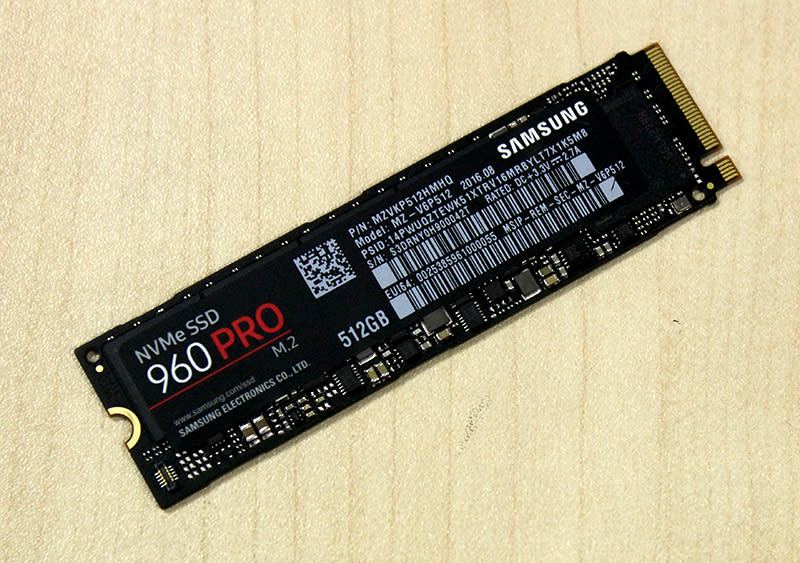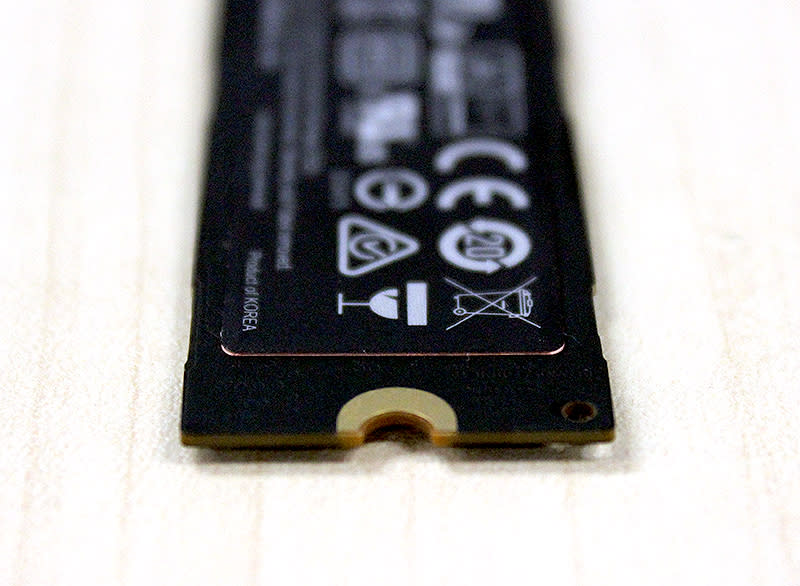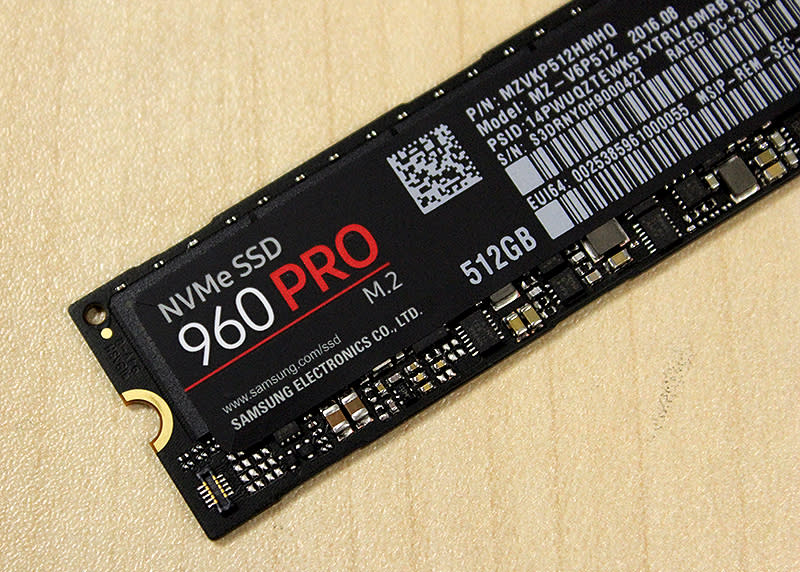Samsung SSD 960 Pro review: Raising the bar for SSDs
Note: This article was first published on 18th October 2016, but it's now re-published in January 2017 as the product is now widely available in retailers.
Is this Samsung’s greatest SSD yet?
For the past few years, Samsung’s annual Global SSD Summit meant one thing: a new flagship consumer SSD. Last year, it was the SSD 950 Pro, which also won our Tech Awards for this year’s best SSD. And the year before that, it was the SSD 850 Pro, which was the first SSD to make use of V-NAND. Like its successor, the SSD 850 Pro was also crowned the Best SSD at the 2015 Tech Awards. Do you see a pattern here?
If it isn’t obvious to you, Samsung is the world’s leader in flash memory. According to market watchers, Samsung is the runaway leader in terms of market share, garnering something between 30% to 40% of the market. In a distant second is Toshiba, with around 20%; followed by SanDisk with 15%; and then Micron with 13%. And it’s not just in terms of market share. Samsung was also the first to put 3D-NAND into SSDs, and their drives have a reputation for being the fastest in the market.
Speaking of speed, this year’s new SSD 960 Pro promises the biggest improvements in performance we have seen in speeds since SSDs started adopting the faster PCIe 3.0 x4 interface. Samsung is claiming sequential read and write speeds in excess of 3GB/s and 2GB/s respectively, and random read IOPs in numbers that have never been seen before in a consumer SSD. So does the SSD 960 Pro live up to expectations? That’s what we are here to find out.
The Samsung SSD 960 Pro

Currently, the Samsung SSD 960 Pro is only available in the M.2 2280 form factor. There’s no plans for a PCIe add-in card version, but Samsung did say that if there is demand, they will certainly consider offering it.
As you might therefore expect, the SSD 960 Pro is really small, like the stick of a gum. The biggest update to the SSD 960 Pro is the new Polaris controller. According to Samsung, the big improvements in performance can be attributed to this new controller. On the memory side, Samsung is using its latest 48-layer MLC V-NAND, which has a memory density of 256Gbit, and allows for a maximum of 512GB per NAND package.
Endurance is unchanged, with the 512GB variant of the SSD 960 Pro rated good for 400TBW or roughly 200GB of writes per day- the same as a 512GB SSD 950 Pro. The larger capacity SSD 960 Pro drives enjoy even greater endurance, with the 1TB variant rated good for 800TBW (438GB/day), while the 2TB variant has a rating of 1200TBW (657GB/day).
Unfortunately, Samsung hasn’t revealed much to us about this new controller. All we know is that it plays a big part in the SSD 960 Pro’s blistering performance; and that it’s a 5-core processor with one of the five cores dedicated for host communication, the other four cores manage the flash memory. The controller also supports 256-bit AES hardware encryption and TCG Opal for security.
The nifty thing about the controller is that Samsung has designed it such that it can allow the DRAM cache to be mounted directly on top for it. This saves precious space on the M.2 form factor, allowing Samsung to fit up to four NAND packages on a single drive. Samsung calls this a "package on package" design. It’s also thanks to this design, that Samsung was also able to offer a 2TB version of the SSD 960 Pro.

M.2 drives can be prone to heat soak and to avoid this, the SSD 960 Pro features Dynamic Thermal Guard protection. It’s a technology that debuted on older Samsung drives and what it does is that it cuts back on performance to reduce power consumption and heat until the temperature of the drive falls back within safe confines. Essentially, this is thermal throttling and it is the same practice is used in CPUs and GPUs as well.
To reduce the occurrence of thermal throttling, Samsung has added an adhesive label to the back of the SSD 960 Pro. Within this label is thin piece of copper, which Samsung says improves thermal efficiency by around 30%. In their tests, they found that throttling in the SSD 960 Pro occurs roughly about 50% later in sequential read workloads, and over 220% later in sequential write workloads. What this all means is that thermal throttling will be a less likely issue in the new SSD 960 Pro.
With all the ingredients in place, here’s a table to show what users can expect in terms of performance from the SSD 960 Pro. Compared to the last generation SSD 950 Pro, the improvements are simply incredible and we can’t wait to showcase what the SSD 960 Pro is capable as we put it through its paces over the next few pages.
SSD 960 Pro (1TB) | SSD 960 Pro (512GB) | SSD 950 Pro (512GB) | |
|---|---|---|---|
Up to 3,500MB/s | Up to 3,500MB/s | Up to 2,500MB/s | |
Up to 2,100MB/s | Up to 2,100MB/s | Up to 1,500MB/s | |
Up to 440,000 IOPs | Up to 330,000 IOPs | Up to 300,000 IOPs | |
Up to 360,000 IOPs | Up to 330,000 IOPs | Up to 110,000 IOPs |
Finally, Samsung will also introduce a new version of Samsung Magician with the SSD 960 Pro, which will come with a redesigned interface and some new features. One of the new features that was revealed to us at the Global SSD Summit was secure file erase. Unfortunately, we didn't manage to get a copy of the new Magician software for this review.
Time to dig in to see what this speed demon of a drive is capable of, so read on and check out its performance in the following pages.
Test Setup
The drives will be tested on our updated storage testbed using the Windows 10 operating system, which has the following specifications:
Intel Core i7-4770K (3.5GHz)
ASUS Z97-Deluxe/USB 3.1 (Intel Z97 chipset)
2 x 4GB DDR3-1600 memory
MSI GeForce 8600 GTS
Windows 10 Pro
Here is the list of benchmarks used:
AS-SSD benchmark 1.8.5636.36856
CrystalDiskMark 5.0.2
PCMark 8 (Storage suite)
Atto Disk Benchmark 3.0.5
Iometer (version 2006.07.27)
The Samsung SSD 960 Pro’s chief competitor will be OCZ’s new RD400 SSD. As we noted in our review of the RD400, the drive marks a return to form for OCZ and it was more than a handful for the SSD 950 Pro. Stunning performance aside, the RD400 also comes with OCZ’s excellent Advanced Warranty Program for a peace of mind.
Competition from OCZ aside, the SSD 960 Pro will also need to be at its best in order to convince consumers that it’s the undisputed SSD speed king. The SSD 950 Pro is already a really speedy drive and still holds the outright speed title in our benchmarks. Judging from Samsung’s claimed performance figures, the SSD 960 Pro should easily triumph its predecessor. Even so, the SSD 960 Pro will need to be very special to be able to be able to shake off both the OCZ RD400 and Samsung SSD 950 Pro.
A short note about drivers: One thing to note is that while last year’s SSD 950 Pro enjoyed support in the form of dedicated NVMe drivers from Samsung, the new SSD 960 Pro will instead rely on Windows 10’s native NVMe driver. That said, Samsung claims that the native Windows drivers are up to the job.
The following drives were tested for this review:
Samsung SSD 960 Pro (512GB)
Samsung SSD 950 Pro (512GB)
OCZ RD400 (512GB)
Intel SSD 750 Series (400GB)
Kingston HyperX Predator (480GB)
PCMark 8
PCMark 8 is the most up-to-date system benchmarking software from benchmarking specialists Futuremark. It was designed for Windows 8 machines (now updated for Windows 10) and the storage suite test puts drives through a collection of 10 different real life workloads involving applications such as Photoshop, Illustrator, InDesign, Word, Excel and even games like Battlefield 3 and World of Warcraft.
On PCMark 8, the Samsung SSD 960 Pro managed a score of 5082, which is just shy of the SSD 950 Pro and identical to the OCZ RD400. The SSD 960 Pro also scored significantly better than the Intel SSD 750 Series and Kingston HyperX Predator. If we look at the breakdown of the score, we can see that the SSD 960 Pro managed the same average speeds as the OCZ RD400, but it was significantly slower than the SSD 950 Pro - 570.34MB/s vs. 702.51MB/s. It looks like the SSD 950 Pro still has some fight left in it. The Intel SSD 750 Series and Kingston HyperX Predator were no match for the SSD 960 Pro.



CrystalDiskMark 5.0.2 Results
CrystalDiskMark is an easy-to-run and quick utility to use to gauge a drive’s performance. It measures sequential read and write performance and random read and write speeds of random 4KB and 4KB (queue depth 32) data.
Looking at the sequential read and write speeds, we can see that the SSD 950 Pro is still pretty competitive as it recorded slightly higher sequential read speeds (by around 9%) than the new SSD 960 Pro. However, the SSD 960 Pro's write speeds were over 27% faster than its predecessor. The SSD 960 Pro's sequential read and write speeds were miles ahead of the OCZ RD400, Intel SSD 750 Series and Kingston HyperX Predator.
On the 4K workload, the SSD 960 Pro impressed with its high read speeds, as it was over 30% faster than the second-placed SSD 950 Pro. However, its write speeds were pretty disappointing as it lost out to the SSD 950 Pro, RD400 and the SSD 750 Series. It was the same story on the more intensive 4k, 32 queue depth workload. Though the SSD 960 Pro easily outperformed its predecessor, it was still outclassed by the RD400 and SSD 750 Series.



AS SSD 1.8.5636.36856 Results
AS SSD is a benchmark that uses non-compressible and completely random data. This benchmark is useful because some controllers, like the once popular but now defunct SandForce SF-2281, compress data first before moving them around. However, with non-compressible and random data, controllers cannot compress the data first, which forces them to deal with data as they are. Therefore, this is a useful benchmark to prevent drivers using controllers like the SF-2281 controller or similar from gaining an upper hand.
The Samsung SSD 960 Pro began strongly on AS SSD, recording some of the highest speeds on the Copy Benchmark. However, the SSD 950 Pro also showed that it's no pushover, and its scores were actually really close to the newer SSD 960 Pro. Looking at the sequential read and write performance, the SSD 960 Pro's sequential write speeds were impressive and over 35% higher than the SSD 960 Pro and over 210% faster than the RD400!
Unfortunately, the SSD 960 Pro's 4K performance was quite underwhelming. While its 4K read performance was good, its 4K write performance was way below our expectations as it managed just 135.06MB/s, which was about 12% slower than the SSD 950 Pro and over 25% slower than both the RD400 and SSD 750 Series. Fortunately, it redeemed itself on the intensive 4K, 64 queue depth workload, as it was the only drive to record speeds of over 1GB/s on both read and write workloads.




ATTO Disk Benchmark 3.0.2 Results
ATTO is one of the oldest benchmarks around, but it’s still a useful tool to gauge a drive’s adeptness at managing compressible data. It’s also useful for seeing how a drive performs across a variety of different transfer block size. Unsurprisingly, given the sequential nature of the data that ATTO throws at the drive, the SSD 960 Pro was a strong performer. On the large 8MB data block workload, the SSD 960 Pro managed over 3GB/s read speeds and over 2GB/s write speeds. That's about 12% and 28% faster respectively than the second-placed OCZ RD400. It maintained its commanding lead on the smaller 512K data block workload as well.
However, on the smallest 4K data block workload, the SSD 960 Pro was unable to muster any kind of advantage and it was slightly outperformed by both the SSD 950 Pro and RD400. Judging from what we have seen so far, it seems that the new SSD 960 Pro's 4K performance can be a little erratic and unpredictable.



Iometer Results (Part 1)
Lastly, we put the drives through the rigorous grind of Iometer, with different workloads and I/O queue depths. We have chosen to show results from a queue depth of 1 to 5 as this better represents the workloads a typical consumer might face.
So far, the Samsung SSD 960 Pro has impressed us with its very strong sequential read and write performance, and this continued on Iometer. Its performance on the 64K streaming reads and writes workloads were the highest we have seen on any drive, so much so that read performance was nearly double that of its predecessor and its closest competitors. However, the SSD 960 Pro couldn't maintain this lead on the more intensive File and Web Server workloads. On the File Server workload, it was on a par with its predecessor; but on the Web Server workload, the SSD 950 Pro managed to take a slight lead. Nevertheless, the strong showing on the 64K streaming read and write workloads ensured that the SSD 960 Pro was our strongest performer on Iometer.




Iometer Results (Part 2)
Finally, we look at the I/O response times for the workloads reported on the previous page. The Samsung SSD 960 Pro's strong showing on the previous page means that it recorded some of the lowest response times we have seen. Average response times for the 64K streaming reads and writes workloads, in particular, are very low.




Cementing first place
Unsurprisingly, the new Samsung SSD 960 Pro proved to be a fast drive, but perhaps not quite as fast and consistent as we had hoped. Sequential read and write speeds were mostly astonishing and amazing. But when it came to smaller data block and random reads and writes, its performance in some instances were a little erratic and inconsistent. In some instances, it would even trail the older Samsung SSD 950 Pro and OCZ RD400. Hopefully these inconsistencies can be rectified with future firmware updates. But this is nitpicking on the SSD 960 Pro, because there’s no doubt that what we are looking at here is a new SSD speed king.

What is surprising, however, is the SSD 960 Pro’s price. As reported previously, the 512GB version of the SSD 960 Pro will go for S$459. That’s significantly more affordable than the SSD 950 Pro, which has a street price of S$529. It’s also more attractively priced than OCZ’s flagship RD400, which presently goes for around S$500 to S$510, depending on where you shop.
In fact, the only PCIe-based SSD that is more affordable is Kingston’s HyperX Predator, which goes for around S$409. However, this drive doesn’t perform on the same level as the SSD 960 Pro because it relies on the slower PCIe 2.0 x4 interface, which only supports half the bandwidth of the SSD 960 Pro’s PCIe 3.0 x4 interface.
With its incredible combination of performance and price, the SSD 960 Pro is therefore an easy drive to recommend. In terms of warranty coverage, the SSD 960 Pro can’t quite beat OCZ’s very comprehensive Advanced Warranty Program, but a 5-year long warranty is nothing to scoff at. The SSD 960 Pro also enjoys better endurance ratings than the RD400. For the same 512GB drive, the rated endurance of the SSD 960 Pro is an impressive 400TBW (that's 200GB/day), while the RD400 is "just" 296TBW (162GB/day). Endurance for the larger capacity drives are even more impressive.
Samsung SSD 960 Pro | Samsung SSD 950 Pro | OCZ RD400 | |
|---|---|---|---|
S$459 | S$529 | S$510 | |
~S$0.89 | ~S$1.03 | ~S$0.99 |
And as usual, the SSD 960 Pro will come with Samsung’s usual suite of drive management and data migration utilities; so keeping your drive updated, monitoring its status, and migrating data from your older system should be a cinch.
All in all, the SSD 960 Pro is a timely new arrival from Samsung, and it has successfully raised the bar for high-end consumer SSDs. With rivals OCZ and Plextor both releasing their flagship drives in the past couple of months, the SSD 960 Pro, with its great performance and super attractive price, ensures that Samsung remains at the very top of their game and gives its competitors more catching up to do.



